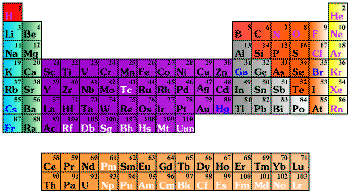BACKGROUND:
The fear of chemistry experienced by many young adults
usually stems from lack of exposure to the table early in their education.
This exercise introduces the periodic table, the basic organizational chart
of the elements, and begins developing a new vocabulary that centers around
the elements. An element is a substance that cannot be broken down into
simpler materials by normal chemical methods. Every day, students hear words
like calcium, lead, iron, magnesium, carbon, and oxygen in advertisements.
These words are used to sell a product; the aim is not to educate but to
make people believe that because of this "magic" ingredient they
should buy the product. However, if the students can realize that these are
not magic ingredients, but naturally occurring ingredients, they would be
better equipped to evaluate the advertiser's claims.
For instance, many commercials insist that
"calcium makes your bones grow stronger." Children (and adults)
get the idea that you can buy calcium in its pure elemental form. However,
in its pure state calcium is a highly reactive whitish metal. The
"calcium" as purchased from stores actually occurs in combination
with other elements (a compound).
PROCEDURE:
- Pass out the Periodic Table Placemats. As the
students look at the periodic table, begin to discuss what is on the
table. State that this table has all the ingredients of every substance
that they see in the world. These ingredients are called elements. Even
the ingredients that make up the human body are included in this table.
You may want to have the students find the
elements that make up the human body. These include carbon (C), hydrogen
(H), and oxygen (O) along with others.
- Notice that the Periodic Table Placemat indicates
the different states of matter of each of the elements. This refers to
the natural state of the element. For instance oxygen is a gas; mercury
is a liquid; and silicon is a solid.
- Chemists are people who study these ingredients,
and they don't like to write the full names of the elements. They have
thus developed a short way to write the names of the
"ingredients" or elements. Go over a few of these shortcuts.
Nickel is Ni; copper is Cu and oxygen is O. You may want to state the
element and the short cut and see if the student can find the letters.
You may be able to do this exercise several times, as you will discover
that young children love this "short cut."
- For an additional activity, have the students find
all the elements that begin with certain letters of the alphabet. For
example, have them find all the elements that begin with the letter
"A". The goal of this activity is to allow children the
opportunity to become acquainted with the periodic table, not memorize
it. As the students mature they will be familiar with the table and will
not shy away from it later years.

Click on picture to enlarge
|